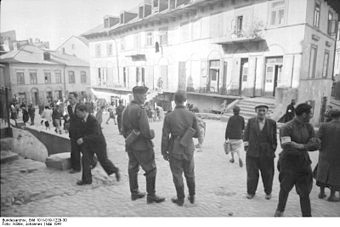Lublin, Poland
Lublin Ghetto
From Wikipedia, the free encyclopedia
This article is about the ghetto. For the Lublin reservation and the Lublin-Lipowa camp, see Nisko Plan.
Two German soldiers in the Lublin Ghetto, May 1941
Odilo Globocnik in 1938, future head of genocidal
Operation Reinhard in Lublin
Jewish women in occupied Lublin, September 1939
From pastoral images of Jews by the SS, Lublin, December 1940
The Lublin Ghetto was a World War II ghetto created by Nazi Germany in the city of Lublin in occupied Poland,[1] on the Nazi-administered territory of the General Government. Its inhabitants were mostly Polish Jews, although a number of Roma were also present.[2] The Lublin Ghetto, set up in March 1941, was one of the first Nazi-era ghettos in occupied Poland to be liquidated.[3] In November 1942 around 30,000 inmates were delivered to their deaths in cattle trucks at the Bełżec extermination camp and additional 4,000 at Majdanek.[1][4]
For more details on this topic, see Jewish ghettos in German-occupied Poland.
History
Already in 1940, before the actual ghetto was opened, the SS and Police Leader Odilo Globocnik (the SS district-commander who also set up the nearby Jewish reservation), began to move the Lublin Jews away from his staff headquarters and into a new area set up for this purpose. Ten thousand Jews had been expelled from Lublin to the rural surroundings of the town in early March.[5]
The Ghetto, referred to as the Jewish quarter or Wohngebiet der Juden, was opened on March 24, 1941. The expulsion and ghettoization of Jews was decided in early March when the Wehrmacht troops, preparing for the invasion of the Soviet Union, needed housing close to the Nazi-Soviet demarcation line.[5] The Ghetto, the only one in the Lublin district in 1941, was located around the area of Podzamcze, from the Grodzka Gate (at the time called the "Jewish Gate", as it demarcated the boundary between the Jewish and non-Jewish quarters of the city), along the Lubartowska and Unicka streets, until the boundary of the Franciszkańska Street. Various members of Jewish political parties, such as the Bund, were imprisoned in the Lublin Castle and continued to carry out their activities underground.[6]
Liquidation of the Ghetto
At its creation the ghetto imprisoned 34,000 Jews[1] and an unknown number of Roma people. Virtually all of them were dead by the war's end. Most of them, about 30,000, were deported to the Belzec extermination camp (some of them through the Piaski ghetto) between March 17 and April 11, 1942; the German set quota called for 1,400 people per day to be sent to their deaths. The other 4,000 people were first moved to the Majdan Tatarski ghetto (a second ghetto established in the suburb of Lublin) and then either killed there or sent to the nearby KL Lublin/Majdanek concentration camp.[1] The last of the Ghetto's former residents still in German captivity were executed at Majdanek and Trawniki camps in the Operation Harvest Festival (German: Aktion Erntefest) on November 3, 1943.[7] At the time of the liquidation of the ghetto, the German propaganda minister, Joseph Goebbels wrote in his diary, "The procedure is pretty barbaric, and not to be described here more definitely. Not much will remain of the Jews."[1]
Showers (left) and gas chambers (right) at Majdanek
After liquidating the Lublin Ghetto, German authorities employed a forced labor work force of inmates of Majdanek to demolish and dismantle the area of the former ghetto, including in the nearby village of Wieniawa and the Podzamcze district, and in a symbolical event blew up the Maharam's Synagogue (built in the 17th century in honor of Meir Lublin). In that way they erased several centuries of Jewish culture and society in Lublin – the Jewish population in 1939 was about a third of the town's total population.[7]
A few individuals managed to escape the liquidation of the Lublin Ghetto and made their way to the Warsaw Ghetto, bringing the news of the destruction with them.[1] The eyewitness evidence convinced some Warsaw Jews that in fact, the Germans were intent on exterminating the whole of the Jewish population in Poland.[8] However, others, including head of the Warsaw's Judenrat, Adam Czerniaków, at the time dismissed these reports of mass murders as "exaggerations".[3] In total, only 230 Lublin Jews survived the German occupation.

Wikimedia Commons has media related to Lublin Ghetto.









